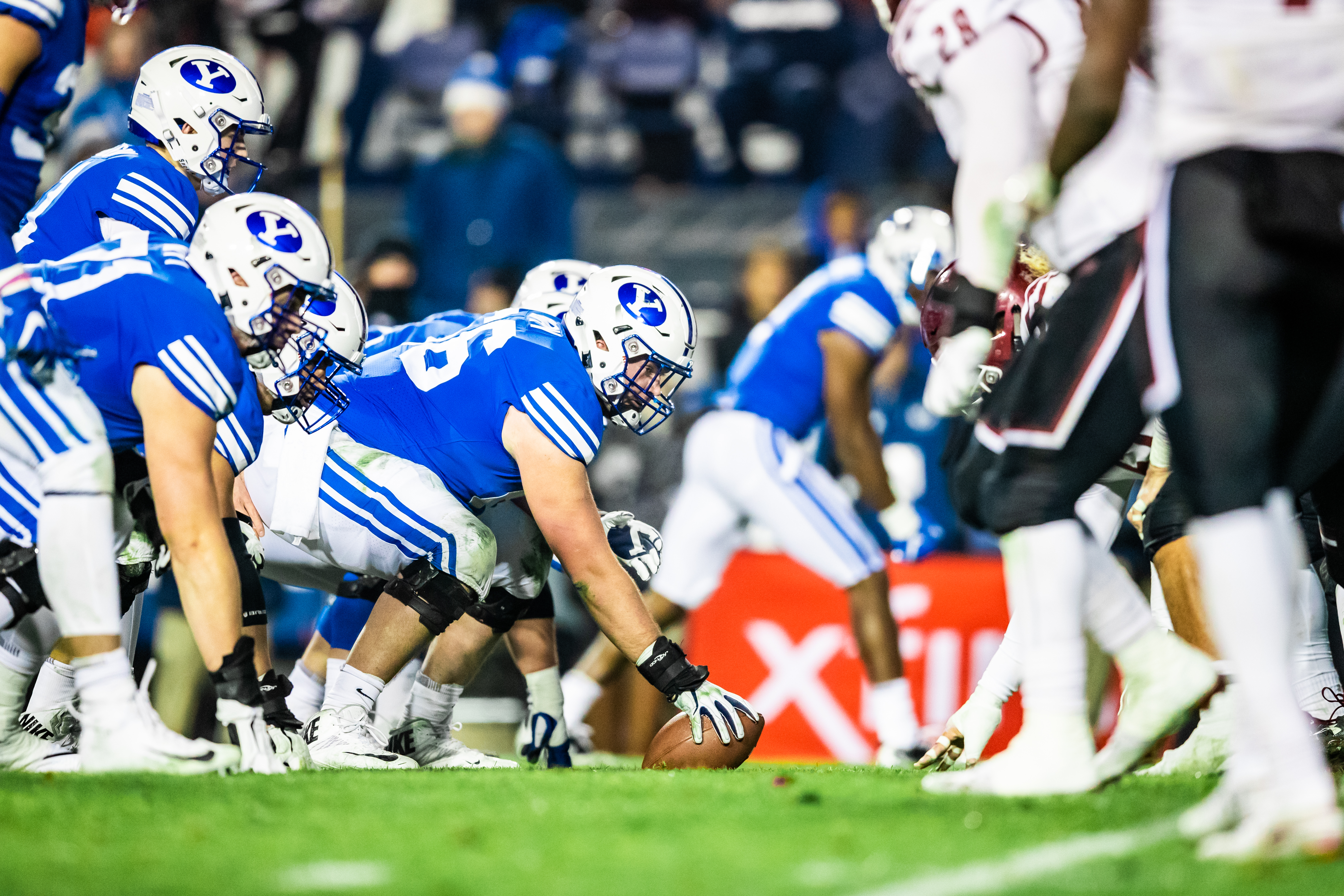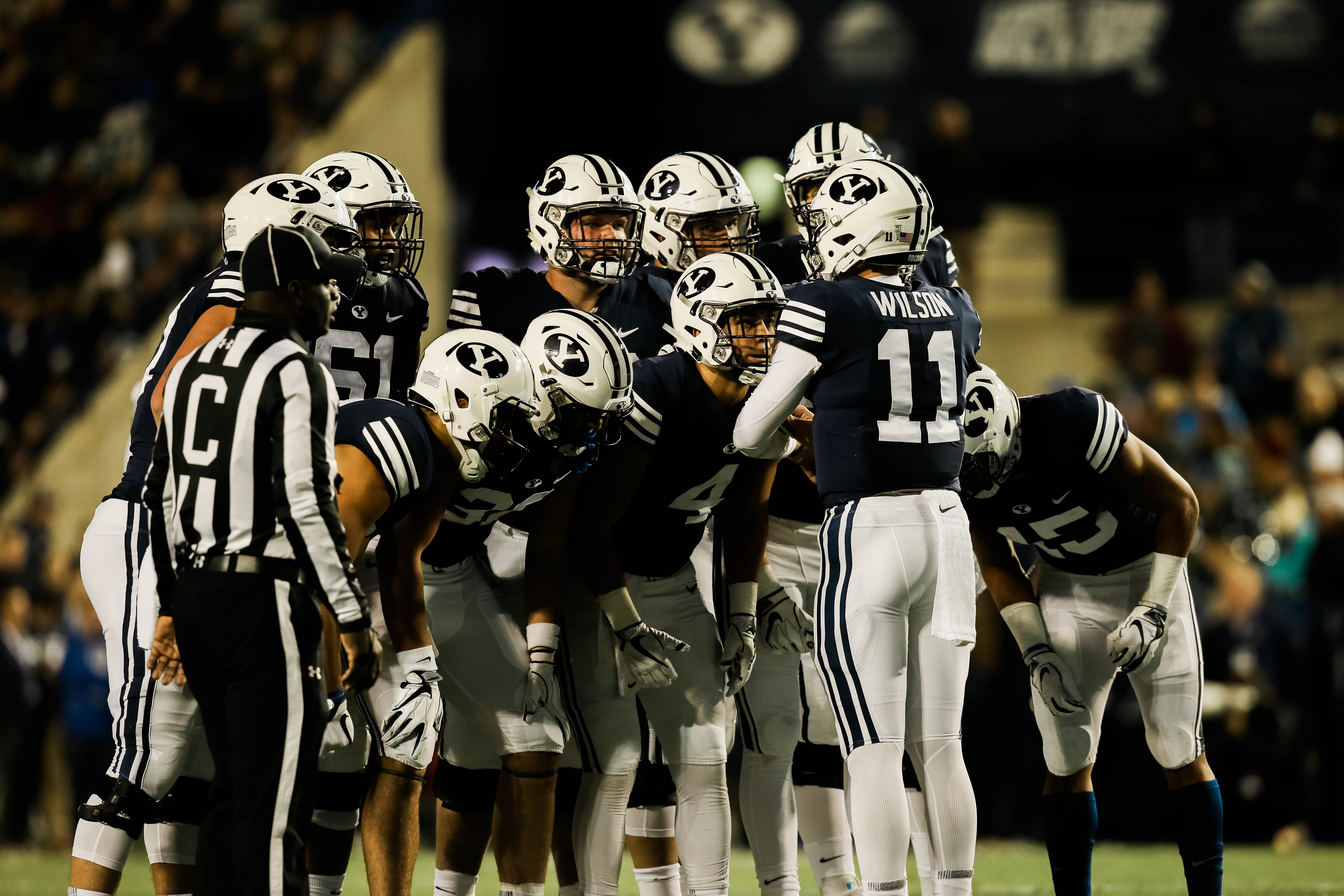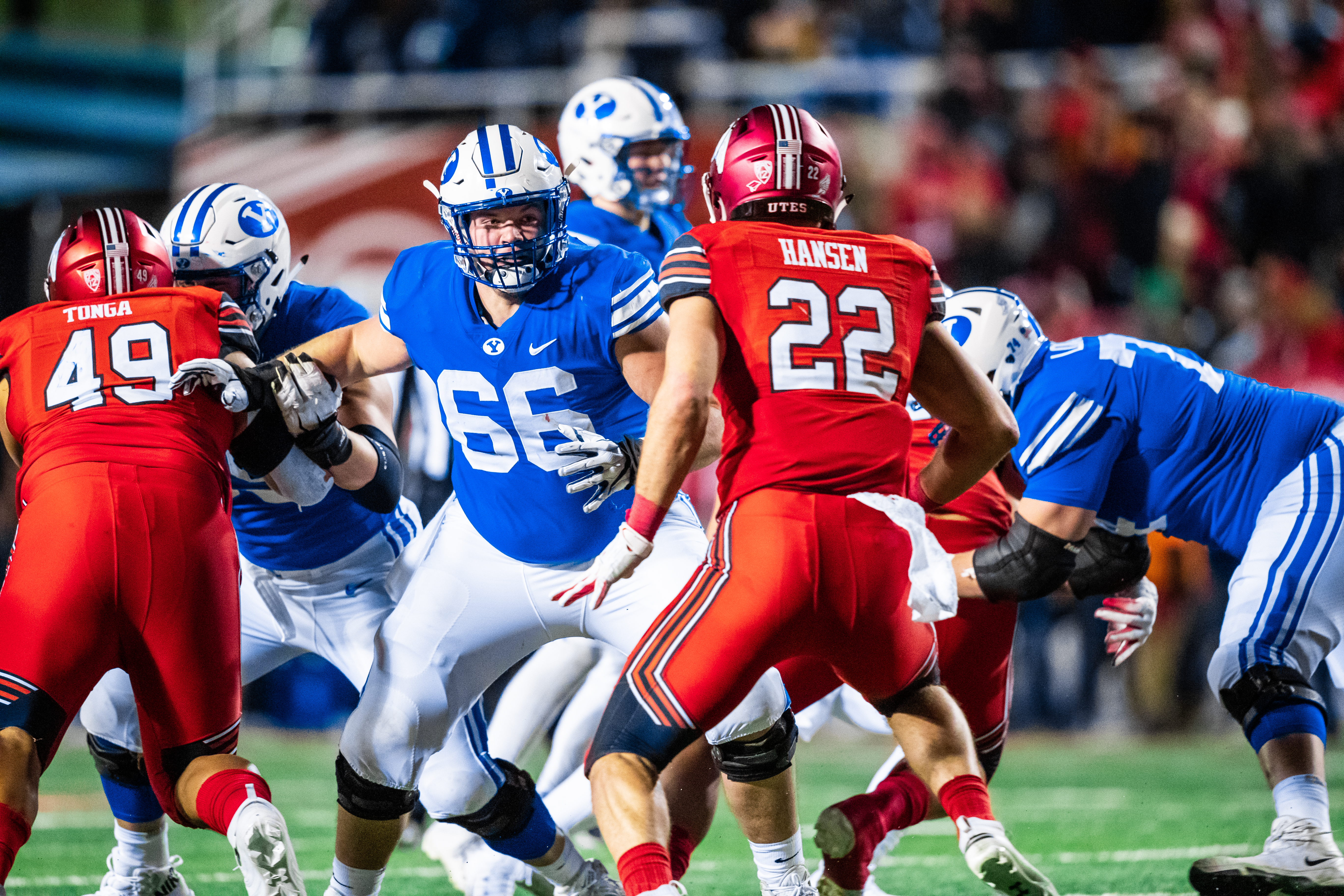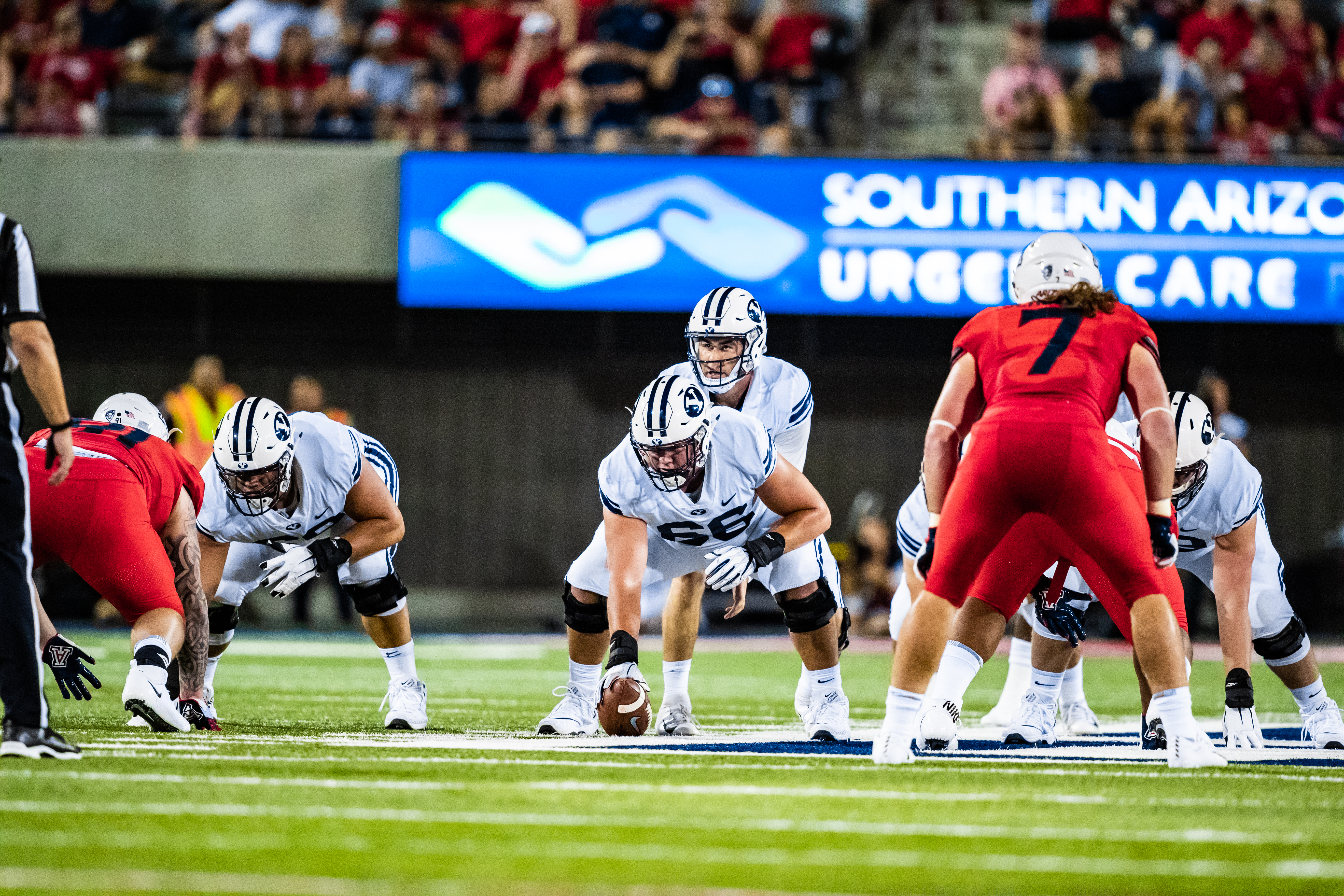
Four rival schools, BYU, Utah, Utah State and Boise State, have elite quarterbacks and running backs, but in front of every great running back and quarterback are five players that make up an offensive line — perhaps the most important piece to running a smooth offense.
Each university bolsters an offensive line with unique strengths of their own — Utah State’s ability to avoid the sack, Utah’s size, BYU’s promise and Boise State’s experience.
The Cougars are bringing back three linemen that started every game last season — Brady Christensen, James Empey and Tristen Hoge. Empey and Christensen are both coming off strong 2018 freshman campaigns for BYU, and Empey was placed on the nation’s Freshman All-American team. Hoge, a transfer from Notre Dame, comes into his second year playing for BYU with a resume that boasts top recognitions — former U.S. All-American Army Bowl participant and No. 1 ranked center in the 2015 recruiting class.
“I want to be a dominant player this year,” Hoge said. “One thing with that is consistency, but also being physically imposing on the field.”
Kieffer Longson and Harrison LaChance could join these three upfront. It is difficult to know who will round out the starting offensive line because of the Cougars’ strength in depth upfront, but these two are a likely pairing. Between the two of them, they have 15 games of experience with Longson starting three of those games. LaChance elected to redshirt his 2018 freshman season after playing in four games, but at 6-foot-8 and 305 pounds, he’ll add much-needed size to an offensive line that ranks last among these four rivals in average weight.

This potential starting five has a 6-foot-6 average height, an average weight of 303 pounds and started in 42 combined games last season. The Cougars allowed 29 sacks in 2018 for a combined loss of 204 yards. Many of these sacks came before current quarterback Zach Wilson took over at the position.
“We have a lot of experienced guys coming back, and all of these guys have played, so they’re coming back with knowledge and experience,” Hodge said. “I think it bodes really well for us. We’re a cohesive unit and we keep getting better.”
Utah is likely to return four starters who combined for 27 offensive line starts in 2018, but it lost three starters to the 2019 NFL draft during this offseason. Adding junior college star Bamidele “Bam” Olaseni to the line will bolster Utah’s already strong unit. Olaseni was a four-star recruit and the No. 9 ranked junior college offensive tackle in the country before joining the Utes.

Utah’s offensive line is a greater mystery than BYU’s because several players are vying for a starting spot, but Nick Ford, Paul Toala, Orlando Umana and Darrin Paulo could be joining Olaseni. Sataoa Laumea is one of those players with a realistic chance of starting for Utah at some point, but given his lack of NCAA experience, it would be hard to place him above any of the other five players that could be starting right now. Laumea comes in as a four-star recruit and the No. 20 ranked guard in the 2019 recruiting class, according to 247sports.
The potential starting five for the Utes have a 6-foot-5 average height comparable to that of BYU’s offensive line. The difference in size, however, is shown in the line’s weight — averaging 319 pounds, the Utes have heaviest of the four offensive lines. Last season, Utah allowed 32 sacks, totalling 196 yards lost.
Since 2014, every offensive tackle that has started for the Utes has been drafted by an NFL team.
Since 2014, every offensive tackle that has started a game for the Utes has been drafted.
? CJ Poutasi
? Garett Bolles
? JJ Dielman
? Sam Tevi
? Jackson Barton #TackleFactory #OBLOCK pic.twitter.com/oBU2wiYyIU— Utah Football (@Utah_Football) May 13, 2019
Utah State could face problems this season because of an extreme lack of experience on the offensive line. The Aggies saw three of their offensive linemen graduate last season, with graduates Roman Andrus and Robert Castaneda starting every game for the Aggies in 2018. Because of this, the Aggies offensive line will likely play three players who didn’t start a game last season. The two remaining likely starters, Demytrick Ali’ifua and Alfred Edwards, started just 13 combined games in 2018.
Keeping quarterback Jordan Love healthy is a must for Utah State if it hopes to see a successful 2019 campaign. Luckily for the unexperienced Aggies offensive line, Love is known to be a scrambler that doesn’t need a lot of time in the pocket. Last year alone, the Aggies only allowed only 10 sacks, losing just 70 total yards. This was in part because of a strong senior class of linemen, but also largely because of Love’s quick feet and split-second reaction time. Though the Aggies’ inexperience on the offensive line will likely be exposed at the beginning of the season, Love will likely help this unit look more experienced.

The Aggies potential offensive line has an average height of 6-foot-5 with an average weight of 304 pounds. Utah State’s offensive line put up the best numbers of the four units last season.
Boise State is facing the exact opposite situation coming into the 2019 season. The Broncos are returning all five of their main starters from last season, with three of their returning linemen having started all 13 games. Of the two players that didn’t start the entire season, John Ojukwu and Eric Quevedo, Ojukwu missed three games to injury, and Ojukwu started the final seven games for the Broncos.
Ezra Cleveland, a likely early-round 2020 NFL Draft pick, is a huge name to watch for the Broncos. Cleveland was ranked seventh among offensive tackles by PFF College Football during his sophomore season.
The nation's highest-graded offensive tackles pic.twitter.com/BS7K1aaIc7
— PFF College (@PFF_College) December 11, 2018
The two remaining starters, John Molchon and Garrett Larson, both add athleticism to this star-studded offensive line. Molchon played basketball in high school, and Larson is a former Idaho state wrestling heavyweight division champion.
Boise State’s starting five have an average height of 6-foot-5 and average weight of 311 pounds. Last season, Boise State allowed 32 sacks for a loss of 183 yards, but its quarterback, Brett Rypien, was voted the Mountain West Conference player of the year — in large part because of the offensive line.
Boise State appears to be the best offensive line on paper, and Utah State is likely to have the weakest of the four rivals. BYU should edge out Utah for the second spot based on experience and potential.




